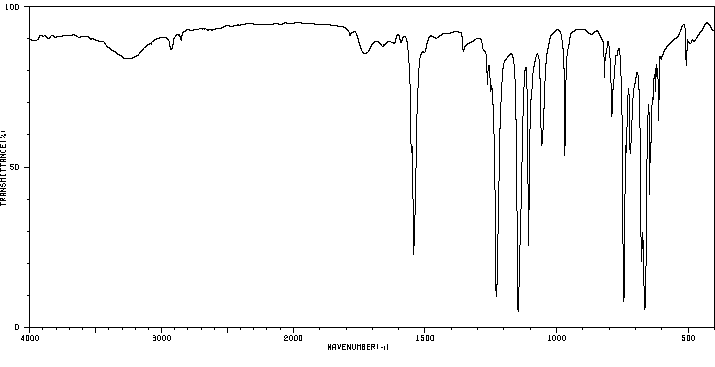八氯环庚三烯 | 21703-93-5
中文名称
八氯环庚三烯
中文别名
——
英文名称
octachlorocycloheptatriene
英文别名
Octachloro-1,3,5-cycloheptatriene;1,2,3,4,5,6,7,7-octachlorocyclohepta-1,3,5-triene
CAS
21703-93-5
化学式
C7Cl8
mdl
——
分子量
367.701
InChiKey
YUWBWGNRIUFWCC-UHFFFAOYSA-N
BEILSTEIN
——
EINECS
——
-
物化性质
-
计算性质
-
ADMET
-
安全信息
-
SDS
-
制备方法与用途
-
上下游信息
-
文献信息
-
表征谱图
-
同类化合物
-
相关功能分类
-
相关结构分类
计算性质
-
辛醇/水分配系数(LogP):6.5
-
重原子数:15
-
可旋转键数:0
-
环数:1.0
-
sp3杂化的碳原子比例:0.14
-
拓扑面积:0
-
氢给体数:0
-
氢受体数:0
反应信息
-
作为反应物:参考文献:名称:The metal-mediated conversion of octachlorocycloheptatriene into dodecachloroheptafulvalene: a synthetic, structural, and EHMO study摘要:八氯环庚三烯,C7Cl8,与多种有机金属前体反应,例如Fe2(CO)9,Co2(CO)8,[(C5H5)Fe(CO)2] -,产生十二氯七氟烯,C14C12,12,收率为54%至68%。没有证据支持C7Cl6 = MLn这种类型的卡宾配合物的中间体存在,因此建议反应通过C7Cl8的脱氯反应进行,从而产生六氯环戊烯,其二聚体形成观察到的产物。扩展的Hückel分子轨道计算用于表明氯化卡宾C7Cl6应比相应的母体系统C7Cl6更稳定。EHMO计算还显示,平面七氟烯在电子上不受欢迎,应该优先以S-anti构象存在,就像C14H12一样。X射线晶体学显示,分子C14Cl12,12仅以同构体形式形成,其在高温下异构化为反式结构。 12中的两个七元环的构象与八氯环庚三烯本身非常相似。C7Cl8,3以正交晶系空间群Pnma结晶,a = 7.140(1)Å,b = 13.329(3)Å,c = 12.595(3)Å,V = 1198.7(4)Å3,Z = 4.3采用严重弯曲的船型结构,其中平面C(1)-C(7)-C(6)和C(2)-C(3)-C(4)-C(5)分别与C(1)-C(2)-C(5)-C(6)平面成51.8°和32.4°的角度。关键词:八氯环庚三烯,七氟烯,金属介导的二聚化。DOI:10.1139/v96-254
-
作为产物:参考文献:名称:Octachlorocycloheptatriene and related compounds摘要:DOI:10.1021/ja00744a014
文献信息
-
Preparation of Polyacetoxytropones and Polyhydroxytropolones by Acetolysis and Hydrolysis of Halotroponoids by Acetyl Trifluoroacetate with Exhaustive Displacement of Halogens on the Tropone Ring. Predominant Formation of Reductive Acetolysates from Fully-Substituted Tropones作者:Hitoshi Takeshita、Akira Mori、Tomoyuki Kusaba、Hiroyasu WatanabeDOI:10.1246/bcsj.60.4325日期:1987.12acetic acid-mediated reduction of intermediary formed acetoxy-p-tropoquinone equivalents. A couple of 2,7-unsubstituted 3,4-diacetoxytropones were deduced to have cyclized 1,3-dioxole structures, 2-acetoxy-2-methyl-5H-cyclohepta-1,3-dioxol-5-ones. An acetolysis of the brominated 5-isopropyltropolones furnished an acetylated by-product, 2,3,7-triacetoxy-5-(1,1-dimethyl-2-oxopropyl)tropone, which might be通过将相应的卤代托品酮或多卤代托品酮与乙酰基三氟乙酸酯进行乙酰水解,然后进行乙酸水解,可以高产率地制备二、三和四羟基托品酮。然而,使用相同的处理获得具有完全取代的乙酰氧基卤代酮的六乙酰氧托酮主要产生比预期更少的取代乙酰氧托酮;已证明形成机制涉及乙酸介导的中间形成的乙酰氧基-对-原苯醌等效物的还原。一些 2,7-未取代的 3,4-diacetoxytropones 被推导出具有环化的 1,3-dioxole 结构,2-acetoxy-2-methyl-5H-cyclohepta-1,3-dioxol-5-ones。溴化 5-异丙基托酚酮的乙酰化提供乙酰化副产物 2,3,7-三乙酰氧基-5-(1,1-二甲基-2-氧代丙基)托酮,
-
PENTACHLOROTROPOLONE AND 3-HYDROXYPENTACHLOROTROPONE作者:Kousuke Kusuda、Nobuya Hara、Robert WestDOI:10.1246/cl.1982.1119日期:1982.8.5Pentachlorotropolone(3) was obtained by treatment of octachlorocycloheptatriene(1) with concentrated sulfuric acid. Chlorination of 3 in liquid chlorine afforded a perchlorinated seven-membered reductone(12). Photolysis of 4-hydroxypentachlorobicyclo [3.2.0]hepta-3,6-dien-2-one(18) gave 3-hydroxypentachlorotropone(19).
-
METHOD OF PRODUCING CATALYST COMPONENT FOR OLEFIN POLYMERIZATION申请人:Tonen Corporation公开号:EP0440813A1公开(公告)日:1991-08-14A method of effectively producing an olefin polymerization catalyst component which exhibits a high activity of polymerizing an olefin to give a polymer having a reduced content of low molecular components, said method comprising bringing into contact with one another (a) metallic magnesium, (b) a halogenated hydrocarbon represented by a general formula RX, wherein R represents C₁ to C₂₀ alkyl, aryl or cycloalkyl, and X represents halogen, and (c) a compound of a general formula X¹nM(OR¹)m-n, wherein X¹ represents hydrogen, halogen or C₁ to C₂₀ hydrocarbyl, M represents boron, carbon, aluminum, silicon or phosphorus, R¹ represents C₁ to C₂₀ hydrocarbyl, m is a valence of M, and m > n ≧ 0, to give a magnesium-containing solid; bringing the solid into contact with a halogenated alcohol; and bringing the product of contact further into contact with a titanium compound and a solid halogenated hydrocarbon.一种有效生产烯烃聚合催化剂组分的方法,该组分具有聚合烯烃的高活性,从而得到低分子组分含量降低的聚合物,所述方法包括使以下物质相互接触:(a)金属镁;(b)通式 RX.代表的卤代烃,其中 R 代表 C₁至 C₂₀烷基、芳基或环烷基;以及 X 代表卤素、其中 R 代表 C₁ 至 C₂₀ 烷基、芳基或环烷基,X 代表卤素,以及 (c) 通式 X¹nM(OR¹)m-n 的化合物,其中 X¹ 代表氢、卤素或 C₁ 至 C₂₀ 烃基、M 代表硼、碳、铝、硅或磷,R¹ 代表 C₁ 至 C₂₀烃基,m 是 M 的化合价,且 m > n ≧ 0,从而得到含镁固体;使固体与卤代醇接触;以及使接触产物进一步与钛化合物和固体卤代烃接触。
-
Reactions of Dimethoxycarbene with Cyclic Perchlorinated Olefins and Ketones作者:James A. Dunn、John Paul Pezacki、Michael J. McGlinchey、John WarkentinDOI:10.1021/jo9823846日期:1999.6.1Reactions of dimnethoxycarbene (2), a carbonyl group equivalent, with perchlorinated olefins and ketones were investigated. Thermolysis of 2,2-dimethoxy-5,5-dimethyl-Delta(3)-1,3,4-oxadiazoline (1) at 110 degrees C generated 2, which reacted with hexachlorocyclopentadiene (4), octachlorocycloheptatriene (12), octachlolobicyclo[3.2.0]hepta-3,6-diene (24), hexachlorotropone (28), hexachlorobicyclo[3.2.0]-hepta-3,6-dien-2-one (32), and tetrachloro-1,4-benzoquinone (35). Reactions of 2 with perchlorinated olefins 4, 12, and 24 led to esters or, in the case of 12, to a ketene acetal. Their formation is rationalized in terms of Michael-like addition and displacement (S(N)2' or S(N)2", if concerted) of allylic chlorine atoms by 2, yielding ion pairs that either dechloromethylate to esters or dechlorinate to a ketene acetal, In contrast, the reactions of 2 with unsaturated perchloroketones 28, 32, and 35 led to ring contraction, ring expansion, and aromatization, respectively. The products from these reactions are consistent with nucleophilic addition of 2 at the carbonyl moiety rather than Michael-type addition. Dimethoxycarbene-d(3) was used to show that demethylation in the latter reaction was intermolecular. Mechanisms for the different reaction courses are proposed.
-
Lou, Yan; He, Yigang; Kendall, John T., Journal of Organic Chemistry, 2003, vol. 68, # 10, p. 3891 - 3895作者:Lou, Yan、He, Yigang、Kendall, John T.、Lemal, David M.DOI:——日期:——
表征谱图
-
氢谱1HNMR
-
质谱MS
-
碳谱13CNMR
-
红外IR
-
拉曼Raman
-
峰位数据
-
峰位匹配
-
表征信息
同类化合物
顺式-3-甲基-1,2,3,4-四氯-1-丁烯
顺式-1-溴-1-丙烯
顺式-1-氯-1-丁烯
顺式-1,3-二氯丙烯
顺式-1,2-二碘乙烯
顺式-1,2-二溴乙烯
顺式-1,2-二氟-1-氯乙烯
顺-氯丹
顺-九氯
顺-九氯
顺-1-溴-2-乙氧基乙烯
顺-1,2-二氯乙烯
顺-1,2,4-三氯-3-甲基-2-丁烯
顺,顺-1,2,3,4-四氯-1,3-丁二烯
除螨灵
锗烷,(1-溴-1,2-丙二烯基)三甲基-
锌,氯(三氟乙烯基)-
铜(1+),1,1,2-三氟乙烯
苯甲酸,4-[(1E)-2-[[(4-氯苯基)甲基]磺酰]乙烯基]-
苯并烯氟菌唑中间体
艾日布林-2碘
聚(乙烯-氯代三氟乙烯)
碳化镁碘化物
碘化乙烯
硫丹醇
硅烷,二氯(2-氯乙烯基)甲基-
硅烷,[2-(碘亚甲基)己基]三甲基-,(Z)-
甲碘乙烯
甲氧基全氟丁烷-反式-1,2-二氯乙烯1:1共沸物
甲基烯丙基溴化镁
甲基全氟-1-甲基-2-丙烯基醚
甲基全氟-1-丁基-1-丙烯基醚
甲基全氟-1-丁基-1-丙烯基醚
环丙烷,1,1-二氯-2-(3,3-二氯-2-甲基-2-丙烯基)-2,3,3-三甲基-
环丙烯,1,2-二氟-
特比萘芬杂质
溴西克林
溴甲基烯酮
溴环辛四烯
溴氯丙烯
溴代三氟代乙烯
溴亚甲基环己烷
溴乙烯
溴三碘乙烯
氰尿酰氟
氯磺酸三氟乙烯基酯
氯化聚乙烯
氯乙烯与异丁基乙烯醚共聚物
氯乙烯与三氯乙烯聚合物
氯乙烯-d3








